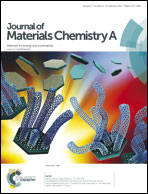A new solution-processed diketopyrrolopyrrole donor for non-fullerene small-molecule solar cells†
Abstract
In solution-processed non-fullerene small-molecule solar cells (NF-SMSCs), the bulk-heterojunction active layer is blended by a small molecule donor and a non-fullerene small molecule acceptor. Synthesis of solution-processed small molecule donors is of the same importance as designing non-fullerene small molecule acceptors. In this paper, a new solution-processed diketopyrrolopyrrole (DPP)-based small molecule donor, namely DPP-BDT-T, was synthesized. The pure DPP-BDT-T film covers a broad spectrum from 500 nm to 700 nm with a low band gap of 1.72 eV. By choosing our newly reported perylene diimide (PDI) dimer, bis-PDI-T-EG, as the non-fullerene small molecule acceptor, the best NF-SMSC device showed a low efficiency of 0.12%. When using 2% 1,8-diiodooctane (DIO) as the additive, more acceptor molecules formed into π–π-stacks, accompanied by the increase of the phase size from 15 nm to 50 nm and the formation of continuous interpenetrating networks. This in turn enhanced the hole and electron mobilities (μh = 1.6 × 10−2vs. 5.8 × 10−4 cm2 V−1 s−1 and μe = 2.3 × 10−5vs. 6.1 × 10−7 cm2 V−1 s−1) and the efficiency was enhanced to 1.6%. In another respect, the fluorescent emission from the blend films was enhanced by 10 times after using 2% DIO as the additive, suggesting less efficient photon-induced exciton separation at the interfaces of the donor and acceptor nanostructures. Accordingly, our case suggests that efficient sweepout of the separated electrons and holes from the nanostructural interfaces plays a role for efficient NF-SMSCs.


 Please wait while we load your content...
Please wait while we load your content...